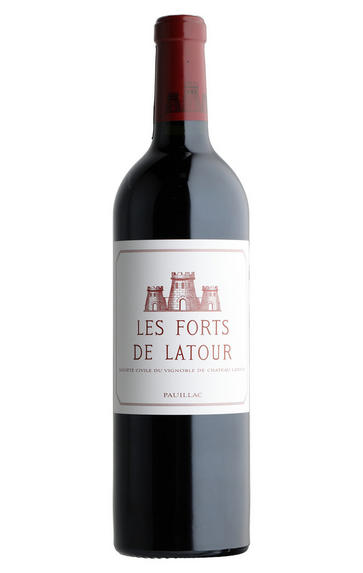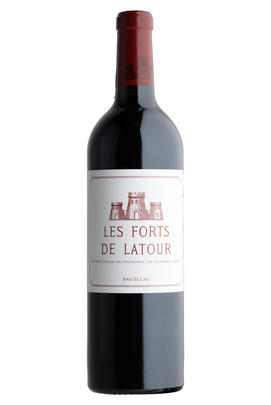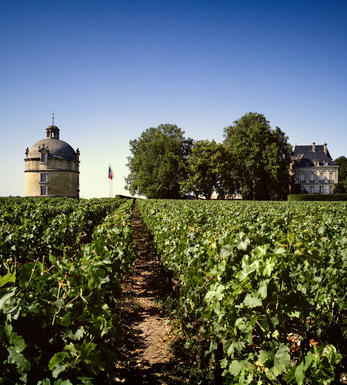
2018 Les Forts de Latour, Pauillac, Bordeaux

Critics reviews
The 2018 Les Forts de Latour has an almost penetrating bouquet of precocious black cherries, orange peel and violet aromas that could almost be a cool-climate Napa (and I don’t mean that in a derogatory way). The palate is powerful and multidimensional, almost bowling over the senses like skittles, so your appreciation depends on whether that is something you desire. Either way, it’s a Les Forts de Latour you won’t forget.
Drink 2023 - 2050
Neal Martin, Vinous.com (November 2019)
The 2018 Les Forts de Latour is surprisingly approachable. It boasts serious concentration because of the warm dry summer and ensuing low yields, yet the intensity of the fruit pretty much covers the tannins, quite unusual for young Forts de Latour. Dark-toned fruit, gravel, incense, licorice and scorched earth add to the wine's distinctive sepia-toned personality. The 2018 turned out beautifully.
Drink now to 2038
Antonio Galloni, Vinous.com (February 2024)
A blend of 65.6% Cabernet Sauvignon, 34% Merlot, and 0.4% Petit Verdot, Les Forts de Latour 2018 has a deep garnet-purple color. It storms out of the glass with powerful scents of blackberry pie, boysenberry preserves, and crème de cassis, melding into a background of sandalwood, Indian spices, dusty soil, and licorice, with a hint of dried flowers. The medium to full-bodied palate is powerful and seductive, delivering firm, grainy tannins and seamless freshness to frame the generous flavors of black fruit preserves, finishing long and opulent.
Drink 2025 - 2050
Lisa Perrotti-Brown MW, The Wine Independent (March 2024)
60% new oak
In the line up, this is a year older than the Pauillac de Latour, but very clearly deeper and more intense in colour, reflecting the 24hl/h yield after a challenging growing season first with mildew and then with the heat of the summer. The rich texture is immediately apparent, and it needs time to open in the glass, as bottle ageing has tamed the exuberance of En Primeur and given way to a classically muscular expression of the estate character.
Those Pauillac tannins are exerting their influence, cradling blackcurrant and damson fruits, cocoa bean, baking spice, graphite, espresso, turmeric and black pepper. A wine that reflects the intensity of the summer, with everything knitted down and austere, I suggest a few more years in bottle before opening to allow more joy to come through, and decant well before serving. 42% of the overall estate production in this wine.
Drink 2025 - 2040
Jane Anson, JaneAnson.com (March 2024)
65.6% Cabernet Sauvignon, 34% Merlot, 0.4% Petit Verdot. 2.4% press wine. 42% of production. Barrel sample.
Black core, purple rim. Intense pure blackcurrant. Dark and scented. Lively, juicy and fresh. More supple than the Pauillac with greater tannic finesse. Lightly charry, savoury and refined and the texture is really elegant even though there's a big tannic charge. Dark, savoury harmony. Direct and long and more aromatic and floral with air.
Drink 2025 - 2035
Julia Harding MW, JancisRobinson.com (April 2019)
The 2018 Les Forts de Latour is made up of 65.6% Cabernet Sauvignon, 34% Merlot and 0.4% Petit Verdot, with 14.2% alcohol and an IPT (total polyphenol index) of 77. It was aged in 60% new oak. Deep garnet-purple in color, it needs a fair bit of swirling to reveal notions of baked black cherries, cassis and blackberry pie with hints of pencil lead, clove oil, cardamom and allspice with a waft of violets. Medium to full-bodied, the palate delivers impressive density with velvety tannins and a lively backbone supporting the generous black fruits, finishing long with all the earthy nuances coming through at the very end.
Drink 2025 - 2045
Lisa Perrotti-Brown, Wine Advocate (March 2021)
A solid and steely red with lots of blackcurrant and blueberry character. Medium-to full-bodied and polished, fine tannins. Flavorful finish.
James Suckling, JamesSuckling.com (April 2019)
This is pretty serious and will take its time to come round with more evident austerity than many second wines in Pauillac in this vintage, no doubt a reflection of the high amount of tannins, but it’s clearly extremely good quality with real bite and attitude.It’s reflective of the estate’s first wine in 2018 for sure, and a whiff of 2010 about it, showing bounce and juice but just takes its time to come through.42% of production. 2.4% press wine. 74IPT.
Drink 2024 - 2038
Jane Anson, Decanter.com (April 2019)
Stepping up on the serious scale, the 2018 Les Forts De Latour checks in as a mix of 65.6% Cabernet Sauvignon, 34% Merlot, and just a splash of Petit Verdot. It boasts a deeper purple color as well as powerful notes of high-class smoke tobacco, graphite, crushed rocks, and ample black and blue fruits. Rich, full-bodied, concentrated, and yet still perfectly balanced, it's another brilliant second wine from Latour that competes with most estates’ top wines.
Jeb Dunnuck, JebDunnuck.com (May 2019)
About this WINE

Château Latour
Château Latour is a wine estate in Pauillac, part of the Haut-Medoc sub-region on the Left Bank of Bordeaux. The estate’s history dates back to at least the 14th century, though vineyards were not established here until the 17th century. The estate is located at the southern edge of the Pauillac appellation, bordering the St Julien vineyards of Château Léoville Las Cases. Latour is one of the five First Growths of the 1855 classification, occupying the top tier alongside Châteaux Lafite Rothschild, Margaux, Haut-Brion, and Mouton Rothschild.
Latour is owned by François Pinault, one of France’s wealthiest people. It forms the jewel in the crown of Pinault’s Artémis Domaines, itself part of the larger Groupe Artémis. Other wineries within the portfolio include Clos de Tart and Domaine d’Eugénie in Burgundy; Château Grillet in the Rhône Valley; Champagne Jacquesson; Eisele Vineyard in California’s Napa Valley; and Maisons et Domaines Henriot, which includes holdings in Champagne, Burgundy, and Oregon.
The day-to-day running of Latour is entrusted to the dynamic Frédéric Engerer. Under his stewardship, a major programme of investment has taken place. In 2012, Latour announced that it would no longer offer its wines as part of the Bordeaux En Primeur campaign. Instead, the wines are kept at the estate until such a time as they are ready to be opened and enjoyed. They are then offered through the La Place de Bordeaux distribution system several years after the vintage.
There are three wines produced here. Château Latour, the grand vin, is produced from vines immediately surrounding the château, from the vineyard area known as L’Enclos. Les Forts de Latour, the second wine, was created in 1966. It is now regarded as a great wine in its own right, certainly worthy of Classified Growth status. A third wine, Pauillac de Latour, is usually the product of young vines.
The vineyard is planted to a majority of Cabernet Sauvignon, along with some Merlot and small amounts of Cabernet Franc and Petit Verdot.

Pauillac
Pauillac is the aristocrat of the Médoc boasting boasting 75 percent of the region’s First Growths and with Grand Cru Classés representing 84 percent of Pauillac's production.
For a small town, surrounded by so many familiar and regal names, Pauillac imparts a slightly seedy impression. There are no grand hotels or restaurants – with the honourable exception of the establishments owned by Jean-Michel Cazes – rather a small port and yacht harbour, and a dominant petrochemical plant.
Yet outside the town, , there is arguably the greatest concentration of fabulous vineyards throughout all Bordeaux, including three of the five First Growths. Bordering St Estèphe to the north and St Julien to the south, Pauillac has fine, deep gravel soils with important iron and marl deposits, and a subtle, softly-rolling landscape, cut by a series of small streams running into the Gironde. The vineyards are located on two gravel-rich plateaux, one to the northwest of the town of Pauillac and the other to the south, with the vines reaching a greater depth than anywhere else in the Médoc.
Pauillac's first growths each have their own unique characteristics; Lafite Rothschild, tucked in the northern part of Pauillac on the St Estèphe border, produces Pauillac's most aromatically complex and subtly-flavoured wine. Mouton Rothschild's vineyards lie on a well-drained gravel ridge and - with its high percentage of Cabernet Sauvignon - can produce (in its best years) Pauillac's most decadently rich, fleshy and exotic wine.
Latour, arguably Bordeaux's most consistent First Growth, is located in southern Pauillac next to St Julien. Its soil is gravel-rich with superb drainage, and Latour's vines penetrate as far as five metres into the soil. It produces perhaps the most long-lived wines of the Médoc.
Recommended Châteaux
Ch. Lafite-Rothschild, Ch. Latour, Ch. Mouton-Rothschild, Ch. Pichon-Longueville Baron, Ch. Pichon Longueville Comtesse de Lalande, Ch. Lynch-Bages, Ch. Grand-Puy-Lacoste, Ch, Pontet-Canet, Les Forts de Latour, Ch. Haut-Batailley, Ch. Batailley, Ch. Haut-Bages Libéral.

Cabernet Sauvignon Blend
Cabernet Sauvignon lends itself particularly well in blends with Merlot. This is actually the archetypal Bordeaux blend, though in different proportions in the sub-regions and sometimes topped up with Cabernet Franc, Malbec, and Petit Verdot.
In the Médoc and Graves the percentage of Cabernet Sauvignon in the blend can range from 95% (Mouton-Rothschild) to as low as 40%. It is particularly suited to the dry, warm, free- draining, gravel-rich soils and is responsible for the redolent cassis characteristics as well as the depth of colour, tannic structure and pronounced acidity of Médoc wines. However 100% Cabernet Sauvignon wines can be slightly hollow-tasting in the middle palate and Merlot with its generous, fleshy fruit flavours acts as a perfect foil by filling in this cavity.
In St-Emilion and Pomerol, the blends are Merlot dominated as Cabernet Sauvignon can struggle to ripen there - when it is included, it adds structure and body to the wine. Sassicaia is the most famous Bordeaux blend in Italy and has spawned many imitations, whereby the blend is now firmly established in the New World and particularly in California and Australia.


Buying options
Add to wishlist
Description
The 2018 Les Forts de Latour is surprisingly approachable. It boasts serious concentration because of the warm dry summer and ensuing low yields, yet the intensity of the fruit pretty much covers the tannins, quite unusual for young Forts de Latour. Dark-toned fruit, gravel, incense, licorice and scorched earth add to the wine's distinctive sepia-toned personality. The 2018 turned out beautifully.
Drink now to 2038
Antonio Galloni, Vinous.com (February 2024)
wine at a glance
Delivery and quality guarantee